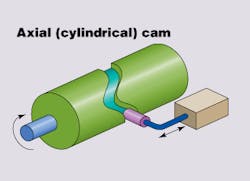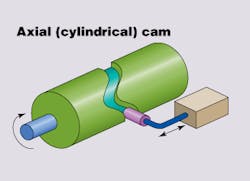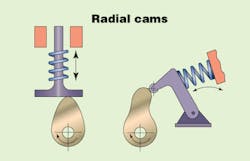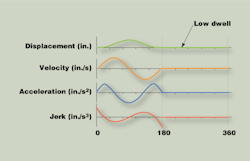Motion Design 101: Mechanical cam types and operation
There can be overlapping functionality between cams and linkages (such as crank-rockers). Where this overlap occurs, the cam usually provides the quicker design solution while presenting a more difficult manufacturing prospect. However, cams go beyond the function of linkage mechanisms, allowing a tremendous range of possibilities for the output motion.
Questions & answers
Q: What are the pros and cons of the different follower contacts?
A: Rolling followers are versatile, durable, and readily available. Followers that slide along the cam, such as flat-faced or pointed, generate more friction than rolling followers, but are attractive due to size and simplicity. Flat-faced followers resist jamming, but cannot trace concave cam profiles. Pointed followers can be useful for detailed cam profiles, but are subject to wear and generate high contact stress.
Q: Which is preferable, rocker or slider motion?
A: A translating follower (slider) can often rotate freely about its shaft. This can be used to help distribute wear by offsetting a flat-faced follower. A follower with a wheel-type contact, though, must remain aligned. Rocker followers often approximate straight-line motion adequately while remaining fixed about their arms.Consider this plot of cam dynamics: Cam design requires you to keep sight of the follower displacement and the first, second, and third derivatives: velocity, acceleration, and jerk. In a valid follower motion, the velocity and acceleration will remain continuous throughout the cycle — otherwise the device produces an impossible, infinite amount of jerk. Obviously, the follower begins and ends the cycle at the same position. Once a suitable output motion is defined, the profile of the cam itself can be generated, often through special software. The diagram depicts an acceptable example of a single-dwell cycle.
Q: What if I want both axial and radial follower motion?
A: Combined axial-radial cams are not unheard of. They are sometimes called three-dimensional cams or camoids.
About the Author
Elisabeth Eitel
Elisabeth Eitel was a Senior Editor at Machine Design magazine until 2014. She has a B.S. in Mechanical Engineering from Fenn College at Cleveland State University.



